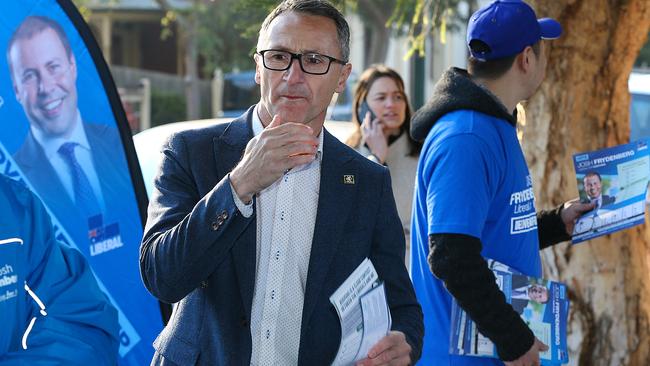
The Australian National University 2019 Election Study is a rich data source that, along with its long-term 1987-2019 trends analysis, offers invaluable insights into how Australia is changing and its opportunities and risks.
Top of the list of risks is a fractured nation. The Liberal Party owns the over-65 vote, with the study showing this split 60-29 per cent Coalition over Labor. Scott Morrison has tied the “grey” vote to his ascendancy, an iron law that will dominate the Prime Minister’s public policy affecting this demographic.
The opposite trend occurs in the under-35 age vote. The election this year saw the lowest Liberal vote for this age group at 23 per cent, a Labor vote at 37 per cent, which is much higher but with a downward trend because the Greens vote has exploded to reach 28 per cent in this demographic. People under 35 were more likely to vote Greens than Liberal, a shocking comment on the Liberals. The Labor vote among under the under-35s is falling as the Greens steal their lunch.
Younger voters are moving to the left and older voters are moving to the right. Taking a broad sample of the nation, among the over-55 age group, 18 per cent more voted Liberal than Labor at the election (a 50-32 per cent split). This is the greatest Liberal lead in this category since the inception of the study in 1987. The Greens vote among over-55s is a dismal 3 per cent.
Ian McAllister, co-author of the study, said: “The generational divide is huge. I think in 10 to 15 years’ time we will be discussing it as the main issue in politics.”
Who does the generational divide assist in the long run? Take your pick — the young vote suggests it will favour the Labor-Greens left but this depends on the assumption that as people age into their 40s and 50s they stay progressive. The case for the Liberals is that because a greater proportion of voters will constitute the over-55 group in future years the split will suit them.
The Greens and Shorten Labor played to the youth vote at the election in ways that accentuated the division. For Labor, it didn’t work. If it becomes the party of the under-35 vote it loses the over-55 vote and loses future elections. Both Morrison and Anthony Albanese need to confront their generational weakness while keeping their generational strength — not easy.
The study, while not explicit, suggests the Liberals made the right move switching from Malcolm Turnbull to Morrison as leader. The public didn’t like the process — it never does — with three out of four voters disapproving of the way it was done. The study rates Morrison as the most popular leader to win an election since Kevin Rudd in 2007, more popular than Tony Abbott in 2013 and Turnbull in 2016.
“Each of the elections between 2010 to 2016 were won by unpopular leaders competing against even more unpopular leaders,” the study says.
The key to Morrison is the study’s finding of his “extreme” popularity among Liberal (and presumably Coalition) voters (where he rated 7.5 out of 10). Morrison has restored much of the Liberal base vote and delivered leadership unity to the party. This is the foundation for his future. Labor, Greens and media onslaughts on Morrison for not being more progressive will be marginal because if Morrison holds anything like his rating among centre-right voters then he wins.
Integral to this was Morrison’s ability, compared with Bill Shorten, to secure a strong preference flow from the Pauline Hanson and Clive Palmer parties. Repeating this next time won’t be easy. Shorten’s parading his left-wing policies meant Hanson and Palmer couldn’t stomach him. But Hanson remains a wildcard and a danger to the government.
Leadership itself was a low rating factor, with only 7 per cent saying they cast a ballot based on leadership. Among Coalition voters, 13 per cent nominated the leadership factor. Among those who did vote on leadership, the split was 6 per cent to 2 per cent Morrison’s way. That is, among those whose vote was based on leadership, 76 per cent voted Coalition. McAllister said it was “certainly right” that the shift to Morrison boosted the Liberal vote but this also raises the unknown factor whether Turnbull would have pulled more votes from the centre.
The study found that Shorten had the second lowest popularity rating out of the 24 major party leaders since the 1987 election. Morrison outrated Shorten on most leadership traits. For Labor, this was a dual problem: Shorten was not just unpopular but that unpopularity undermined every ALP policy position.
And 2019 was a policy election where voters saw major differences between the parties and 66 per cent cast ballots based on policy. This is also where Morrison won since 38 per cent voted on the economy, tax or debt as the most important issue.
On the economy, voters preferred the government over Labor by a huge 47-21 per cent. Among the 20 per cent who named the economy as the most important issue in their vote, the split was 15-4 per cent Morrison’s way. Morrison’s campaign was superbly accurate — he made the economy his campaign centrepiece and stuck by this relentlessly.
Labor faces a steep climb to reinvent itself on the economy. Its huge emphasis on inequality and class didn’t turn votes.
“Labor hasn’t kept up with the complexity of the class issue in Australia,” McAllister said. “Talking about bosses and workers won’t work. Class is more complex playing into social networks and education levels, and Labor has missed these changes over the past 20 years.”
The study reveals Labor’s tax folly but also the great tax trap from which it must learn. Voters supported Labor’s negative gearing policy at 57 per cent and its franking credits policy at 54 per cent. Sounds good? Yet the government was the preferred party on tax policy, beating Labor by a significant 41-28 per cent. The long-term trend since the late 1980s is the same: voters see the Liberals as superior on tax. It is the same story at every election, though 2016 was tight.
“Labor failed to translate support for specific measures into persuading people that its tax changes would benefit the economy in the long run,” McAllister said. “Voters need to be convinced the tax changes are good for the nation’s economy.” This is why John Howard won the 1998 election on the GST tax package. It is where Labor failed in May. It mounted a radical change agenda on tax — an area of Coalition strength and Labor weakness.
The study documents the related Labor failure — the perception took hold, unsurprisingly, that Labor was mounting an assault on the asset-owning class. Asset ownership is more important than occupation in shaping voting behaviour, a point Labor has missed completely. Among homeowners, half voted for the Coalition and one-third voted for Labor. Among investment property owners, 59 per cent backed the Coalition compared with 27 per cent for Labor.
The winning policy issues for Labor that were seen as the most important were health and Medicare (22 per cent), environment and climate change (21 per cent) and education (8 per cent), a low figure given the money Labor pledged. Climate change is driving the agenda — at the 2016 poll fewer than 10 per cent nominated the environment as a top factor. That doubled for this year’s election. The left dominates the global warming issue, with 93 per cent of ALP voters and 98 per cent of Greens voters saying it is quite or extremely important.
Of the 16 per cent of voters who said the environment was the main election issue, the split was: 7 per cent for Labor, 6 per cent for the Greens and 1 per cent for the Coalition. In short, an increase in the primacy of climate change as a voting issue dooms the Coalition on this trend. This is Morrison’s chief vulnerability. Among Coalition voters who switched to Labor, the main reason was climate change.
But Morrison won the policy contest because “there were a greater number of voters that switched from Labor to the Coalition based on economic issues, than from the Coalition to Labor based on environmental issues”. Morrison’s survival depends on retaining this equation.
On Australia’s gender divide the figures are revealing — the Liberal Party’s women problem is real. The study suggests 45 per cent of men gave the Liberals a first preference vote compared with 35 per cent of women. Women, more than men, vote Labor. But the big gulf arises from their support for the Greens — women in 2019 voted Green over men 15 to 9 per cent. Women spearhead the left-progressive vote.
The long-term trends in the study embody a deep paradox: Australia is becoming a more progressive nation on social issues and this should favour Labor, yet the party has failed singularly to capitalise on this advantage. What is the explanation?




Democratic Australia is being torn apart by generational divides and suffers from divides based on gender, location and family assets, yet while the country becomes more progressive on social issues, its priority remains the economy — conclusions that point to a volatile, disloyal and impatient voting public.